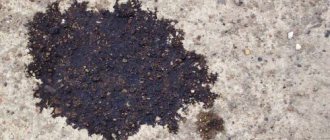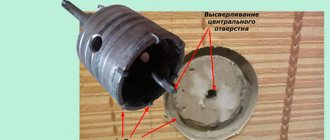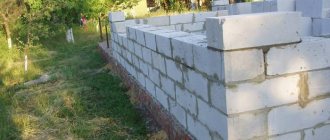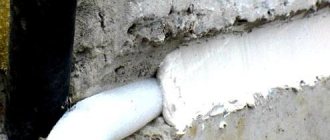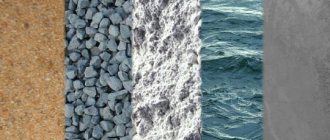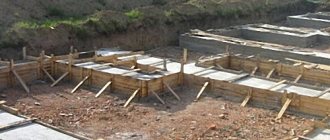Is it possible to add salt to concrete? For what?
It is possible, this is sometimes done when construction is carried out in frosty weather - they add salt to the composition so that the concrete does not freeze.
As you understand, it will take time for the concrete to harden—about two days. In cold weather, the composition may not have time to set, it will simply freeze. At the same time, the ice expands and the structure loses strength. Salt increases the frost resistance of the composition, but at the same time accelerates the corrosion of metal fittings. You can add salt to the concrete solution, which is what manufacturers of dry building mixtures do. As a rule, these are winter products, such as masonry mortars, universal mortars, and construction adhesives. Salt is added to the mixtures so that the water in the solution does not freeze and the hardening process takes place according to the desired algorithm.
There is a negative point to this. After the mortar hardens, during use, white spots appear on such concrete bases or brick folds; they are called efflorescence.
This is the salt that helped carry out construction work in subzero temperatures. Therefore, to prevent such processes of salt coming out of concrete, manufacturers also add special polymer additives to the mixtures, which block the salt in the concrete solution and do not allow it to react with moisture.
Not every manufacturer does this, as this leads to higher prices for their products. If you have a similar situation, I recommend that you use a special impregnation that is used on the finished coating and also blocks salt.
Specifications
Plasticizers for concrete are components based on polymer components and liquid concrete mortar. They are used to ensure the elasticity of the masonry mixture, achieving the desired flow properties and optimal degree of moisture absorption. The additive contains reagents that react with concrete elements, forming a plastic mass. This improves adhesion, increases the density and strength of the mixture.
Certain types of plasticizers give concrete the following properties: increased fluidity, increased frost resistance, increased waterproofing properties
During the hardening process, the solution does not break up into separate fragments and no water is released. And although the hardening time noticeably increases, this is rather a plus, since it becomes possible to correct mistakes made during pouring in a timely manner.
The main condition for a high-quality composition is full compatibility with the elements included in the mixture, a low level of volatility and a high degree of resistance to solvents.
How to make an anti-frost additive for concrete?
To make concrete durable in winter, an anti-frost additive is used. Often these are salts of calcium chloride, sodium chloride, sodium nitrate, which enable concrete to slowly harden at sub-zero temperatures. Salts reduce the freezing point of the liquid in the solution, which shortens the setting period, and, therefore, reduces the amount of cement consumed and financial costs. But a large volume of salt introduced into concrete leads to deterioration of the structure and shortens its service life. If you operate a concrete structure at high humidity, there is a risk of damage to the reinforcement from exposure to chloride salts. Therefore, antifreeze additives should not be used in critical reinforced concrete structures.
Removing Fading in Concrete
Before removing efflorescence from concrete, it is necessary to determine the source and cause of the efflorescence and attempt to reduce its impact.
Removing efflorescence can be broken down into 3 steps.
- Pressurized water
Efflorescence in concrete can be removed using a pressurized water jet. Using pressurized water can quickly dissolve salts. But you need to make sure that the water is completely dry after removing the efflorescence. If the concrete is not dried, that same water can cause efflorescence.
Figure 2: Removing efflorescence using pressurized water.
- Cleaning
Some types of efflorescence can be easily removed with a stiff wire brush or sponge. If your dry brushing results are unsatisfactory, lightly dampen the surface.
- Dissolve in acid
Concentrated acid is not recommended to be applied to concrete; it must be diluted using a ratio of 1:20.
The surface to which the acid is applied must be damp, but without any obvious water. The applied solution should remain on the concrete surface for 10-15 minutes. Then the surface should be thoroughly rinsed and cleaned with plenty of clean water.
Repeat the procedure at least twice or until all traces of the acid solution have been removed.
Figure 3: Removing efflorescence using dilute acid and a brush.
Acid washing may cause discoloration and surface texture. For colored coatings, a more diluted acid solution (1:20 or even 1:50) may be required.
Taking out: Test on a small area first to evaluate the results.
Important: Be careful when performing this procedure. Ensure good ventilation and avoid contact between acid and fittings.
Purpose
Applying antifreeze additives involves a simple technological process that can be easily done with your own hands. An anti-frost additive is intended to maintain the required mobility of the solution, accelerate the hardening of the mixture and accelerate the hydration of the concrete composition. The use of antifreeze admixtures saves the cost of additional heating equipment and payment for central heat supply to the room in the winter season. Thanks to antifreeze additives for concrete, the ability to operate buildings and structures is accelerated, as well as the consumption of impurities in the solution is reduced and energy is saved.
Impurities that allow concrete to maintain its strength characteristics and improve the indoor microclimate during the cold season are divided into the following types:
- Impurities that, by lowering the freezing temperatures of the working mixture, act as a barrier to the crystallization process of water present in the concrete composition. Such additives are called cement mixture hardening retarders or weak hardening accelerators. The process of reducing temperatures is carried out by electrolytes, which are strong and weak.
- Antifreeze additives in the concrete composition accelerate the hardening of the solution and have considerable antifreeze properties.
Return to contents
Sodium and calcium chloride in concrete
Sodium chloride or ordinary construction salt has many advantages, due to which the popularity of this composition increases. Used in construction as an anti-frost component during sub-zero temperatures. Allows you to reduce the crystallization temperature of water.
Calcium chloride is used as an accelerator for the hardening of concrete mortar, as well as to increase its strength and resistance to variable weather conditions. By accelerating the setting process of concrete, the time for installation of cement-based structures is reduced. The use of an anti-frost additive in concrete allows construction to continue during the cold season.
Advantages and disadvantages of use
Antifreeze additives based on sodium chloride have the following advantages:
- due to the salt introduced into the cement mixture, the crystallization temperature of the liquid is reduced, which prevents the destruction of structures and the formation of recesses in monolithic buildings, which lead to pouring in the winter season;
- low cost of the additive;
- technical salt in the solution does not affect the rate of crystallization of the solution, thereby allowing the mixture to be prepared long before its use;
- availability of antifreeze additive;
- the ability to prepare and apply it yourself;
- technical salt in concrete increases the movement of mixture particles, which simplifies the placement and formation of the mass.
Salt in concrete mortar causes reinforcement to rust.
Disadvantages include:
- The possibility of corrosion formation on metal reinforcement, which is laid in concrete mortar to add strength to the structure. Thus, the strength of reinforced concrete structures decreases and their integrity is lost. Salt in the solution of reinforced concrete structures leads to peeling and rusting of products.
- The availability of the composition is considered both an advantage and a disadvantage, because the low price of additives often repels consumers who trust more expensive antifreeze compositions.
The pros and cons of calcium chloride are similar to the pros and cons of sodium chloride. These admixtures are also used in the production of ready-mixed concrete and other complex materials used in construction. Calcium chloride is also used in the installation of paving slabs and curbs. It lowers the crystallization temperature of water and acts as an anti-icing reagent.
Disadvantages include the ability to cause corrosion of reinforcement and the low cost of the material, which is why consumers do not choose such antifreeze additives.
How to add it to the solution correctly?
Salts are added to the solution subject to the following characteristics of the surrounding space:
- the air temperature should be in the range from zero to minus five degrees Celsius, then sodium chloride is added to the composition in a volume of two percent of the total mass of the components (plus half a percent of calcium chloride);
- at an air temperature of minus six to minus fifteen degrees Celsius, construction salt is added in a volume of four percent of the total mass of the components used (and two percent of calcium chloride).
Return to contents
The construction of buildings and structures made of concrete in the winter season is impossible to imagine without the use of antifreeze additives. They simplify installation work and improve the quality of the concrete solution. However, it is important to remember that such construction impurities reduce the strength of concrete during periods of negative temperatures; the final achievement of the strength of the material is possible only during the thawing process.
Thus, structures erected using concrete mortar in the winter should not bear heavy loads.
Salt in concrete or antifreeze additives for construction
At low temperatures, the hardening process of cement mixtures slows down significantly. This is due to the fact that the water included in the building mass crystallizes under such conditions, interfering with the normal hydration process. For fresh concrete, such a situation is disastrous and has a very very bad effect on the strength of the structure being created.
The process of crystallization of water from frost in a fresh solution leads to the fact that it becomes loose and is endowed with low frost-resistant properties. The physics of this process is simple and understandable even to schoolchildren. As water freezes, it expands, which breaks the bond between the cement and the aggregate.
Conclusion
The construction of buildings and structures made of concrete in the winter season is impossible to imagine without the use of antifreeze additives. They simplify installation work and improve the quality of the concrete solution. However, it is important to remember that such construction impurities reduce the strength of concrete during periods of negative temperatures; the final achievement of the strength of the material is possible only during the thawing process.
- 1 Antifreeze additives
- 2 Types of antifreeze additives
- 3 Accelerators of the concrete hardening process
- 4 Sodium chloride in the fight against frost
- 4.1 Main characteristics of CN
- 4.2 The process of adding salt to a solution
At low temperatures, the hardening process of concrete mixtures slows down significantly. This is due to the fact that the water included in the building mass crystallizes under such conditions, preventing the normal passage of the hydration process. For fresh concrete, such a situation is disastrous and has an extremely negative impact on the strength of the structure being created.
The process of crystallization of water from frost in a fresh solution leads to the fact that it becomes loose and is endowed with low frost-resistant properties. The physics of this process is simple and understandable even to a schoolchild. As water freezes, it expands, which breaks the bond between the cement and the aggregate.
Laying out the foundation in winter
Antifreeze additives
Monolithic structures created in warm weather, after drying, are durable and high-quality structures.
Note! The greater strength of reinforced concrete products means that if it is necessary to create a hole in a given structure or shorten it, it is necessary to use methods such as cutting reinforced concrete with diamond wheels and diamond drilling of holes in concrete.
But in order to ensure the same level of strength for cement structures created in winter, it is necessary to use measures that allow water to be retained in the building mass in a liquid state.
Antifreeze additives, which are also called concrete setting and hardening accelerators, can help in this matter. They make it possible to reduce the freezing point of the liquid, thereby helping to normalize the hardening process of the cement monolith structure.
Concrete work in winter - implementation features
It is difficult to call the winter months a favorable period for concreting monolithic structures, pouring foundations and forming bored supports. This is due to the crystallization of water. It complicates the hydration process, which results in the formation of strong bonds at the molecular level. When water expands as a result of crystallization, porosity increases, strength characteristics decrease, and cracking of the mass occurs.
In order for winter concrete to be strong, it is necessary to create conditions or additives for its ripening
After concreting, the following processes occur:
- grasping. The duration of this stage is no more than 24 hours, during which the transition from the liquid state to the solid phase occurs. The strength characteristics are quite low;
- hardening. This is a long process, as a result of which exploitation equipment is purchased over the course of a month.
Types of antifreeze additives
Means for this type on the modern market are presented in two main types:
- Compositions that interfere with the crystallization processes of liquids in building mixtures by lowering the freezing point of the building mass . They are also called retarders or mild cement set accelerators. These substances include two types of electrolytes:
- Strong - table or technical salt for concrete (sodium chloride), sodium nitride;
- not strong - ammonia solution, substances of limited origin (urea, polyhydric alcohols);
- Antifreeze compounds that help accelerate the hardening process and have high antifreeze performance . Such additives include potash, mixtures based on calcium chloride with sodium nitrite, with sodium chloride, etc.
Properties of antifreeze substances
Having decided to make a plasticizer for concrete with your own hands, you should know that anti-frost additives are distinguished by the type of chemical that is added to the solution for the purpose of preparing a concrete solution intended for use in frost. So, in particular, these can be the following chemical elements:
- chloride salts, namely sodium chloride (table salt) and calcium chloride;
- sodium nitrite;
- potassium carbonate or potash.
By using these substances as special additives in the building mixture, during construction you can do without heating the mortar poured into the formwork. It is worth knowing that the same chloride salts significantly increase the corrosion of metal fittings. In this regard, if you decide to prepare concrete with your own hands, add such salts to it only when you are going to concrete unreinforced structures.
Sodium chloride in the fight against frost
NaCl – sodium chloride (CN) or simple commercial salt. Concrete with technical salt is an excellent substance for construction work in winter at subzero temperatures.
Main characteristics of CN
Technical salt is added to the cement mortar to give it anti-frost properties.
This additive has the following properties and features:
- Salt, introduced into the solution with your own hands, allows you to lower the freezing point of water, which will avoid destruction of the structure of the product and the formation of cavities in a monolithic structure that is poured in the winter;
- The price of this supplement is low;
Note! This component for concrete is the most inexpensive antifreeze additive.
- NaCl does not affect the rate of hardening of the solution; therefore, winter concrete with salt may have been mixed long before it was poured. Thus, mixing the building mass with this additive can be done, for example, at the factory long before its transportation to the construction site without loss of fundamental properties;
- Such an additive increases the mobility of solution particles, which facilitates the process of forming products of the desired shape from a given mass;
- It does not change the structure of the cement mass.
Advice. It is recommended to use calcium chloride together with sodium chloride.
The availability of this type of antifreeze additive and its low price is usually the reason that most builders resort to the use of completely different, more expensive means.
In addition to the many advantages of such an additive, it also has one significant drawback, which usually makes it unfeasible to use for concrete. The fact is that salt has a high level of corrosive activity.
And this shows that the use of metal reinforcement at the same time as a cement mixture with the addition of sodium chloride will lead to the process of rusting and peeling of this structure from the concrete.
Thus, the reinforced concrete structure loses its integrity, which significantly reduces the strength level of the entire product.
The process of adding salt to a solution
The instructions stipulating the proportions of salt in the cement mortar are based on the average daily temperature and expected strength:
- The average daily ambient temperature from 0 to -5 degrees suggests the addition of CN in the amount of 2% of the total mass of the mixture. The expected strength of the structure when dried in frost for 7 days will be 30%, 28 days - 80% and 90 days - 100%;
- The average daily ambient temperature from -6 to -15 degrees suggests the addition of CN in the amount of 4% of the total mass of the mixture. The expected strength of the structure when dried in frost for 7 days will be 15%, 28 days - 35% and 90 days - 50%.
Advice. The proportions of salt in concrete also require the addition of calcium chloride in the first case in the amount of 0.5% by weight of the solution, and in the second 2%.
Properties of antifreeze substances
Sometimes it is not possible to purchase a ready-made product, but you don’t want to stop construction. In this situation, you have to make such a plasticizer additive for concrete with your own hands.
The simplest and most affordable way is to add regular table salt to the concrete solution.
In scientific language it is called sodium chloride. Salts, if you remember your school chemistry course, generally help lower the freezing point of solutions.
What to do if you need to protect metal parts? In such a situation, so-called corrosion inhibitors will come to the rescue. These are substances that significantly slow down the rusting of metal elements. This role is most often played by potassium nitrate nitrate (NPN), an intermediate product in the production of potassium nitrate.
To prepare a non-freezing plasticizer for concrete with your own hands, add 3-4% of the volume of dry cement, table salt or potassium chloride and NNC, to the solution along with water. The ratio of NaCl or KCl and potassium nitrite nitrate should be 1:1. To improve the plasticity of concrete, urea is also added to the solution in a volume of 7-10%.
You can make your own anti-frost plasticizer for concrete using ammonia water. This is perhaps the most cost-effective way to make concrete mortar more plastic and not lose strength characteristics in cold weather.
Ammonia water has a significantly lower expansion coefficient than, for example, an aqueous solution of salts. In addition, this substance not only does not contribute to metal corrosion, but, on the contrary, slows it down. Another advantage of this additive is that efflorescence on the masonry appears much less frequently or is absent altogether.
The concentration of ammonia water directly depends on the temperature at which concrete work is carried out. It can range from 5 to 20%. The lower the air temperature, the more concentrated the ammonia water should be.
When making plasticizing antifreeze additives for concrete with your own hands, it is worth remembering that different concrete works require different additives in different quantities. There are special tables for this. They present calculations of additives at different temperature operating conditions.
However, construction industry experts say that for an independent developer it is better to purchase ready-made antifreeze plasticizing mixtures and add them, strictly following the instructions.
You can make your own antifreeze additive for concrete when you don’t have an industrial plasticizer at hand or when you want to give concrete unique properties. Moreover, in some cases, self-production of such an additive allows you to significantly save on construction work, since it can be prepared from cheap auxiliary materials available at hand.
When preparing an anti-frost solution for concrete with your own hands, it is necessary to take into account the fact that different types of plasticizers have different properties and characteristics. It is they who will subsequently influence the characteristics of the concrete itself and structures made from it.
So, for example, chloride salts added to the solution should not account for more than 7.5% of the cement mass. Potassium nitrite in such a mixture should occupy 10%, and potash - 15% of the specific gravity of cement. Moreover, if you use chloride salts as an anti-freeze additive, then by the time the water-salt solution freezes, the strength of the concrete cannot be less than 5.0 MPa. Such concrete must be cured under cover until the stripping strength level is reached.
The use of anti-frost plasticizers makes it possible to avoid heating a concrete structure only when the temperature at the construction site is not lower than the design temperature. If the maximum permissible concentration of chloride salts and sodium nitrite is introduced into the solution, the poured concrete can withstand a temperature of 15°C in the open air without heating.
In any case, if the temperature drops below the specified threshold, it will be necessary to take measures to insulate the formwork and cover the poured structure using the “thermos” method, as well as ensure their heating using steam or electricity.
Concrete solutions with a high level of salt plasticizers are good because they can tolerate negative temperatures when leaving the mixer. At the same time, to mix the mixture itself, you can take cold materials such as sand, crushed stone and gravel. At the same time, their temperature should not be lower than 15°C.
If you want to avoid early setting of the concrete mixture due to the presence of too many chloride plasticizers in it, it is prepared using a separate method. To do this, sand, cement and crushed stone are first mixed together with water, to which an anti-frost plasticizer with 70% mixing water has been added.
When building a house or fence, every site owner wants the structure to have not only an attractive appearance, but also good technical characteristics. To improve these indicators, special substances – plasticizers – are added to the concrete solution. However, a more experienced builder, for economic purposes, often creates a plasticizer for concrete with his own hands. In this way, it is possible to significantly reduce the cost of the component and achieve better performance for the future building.

